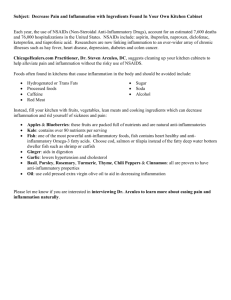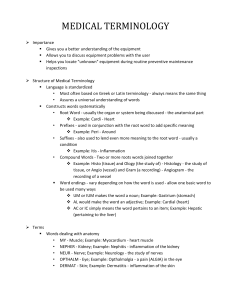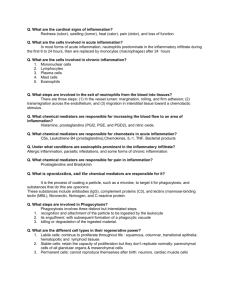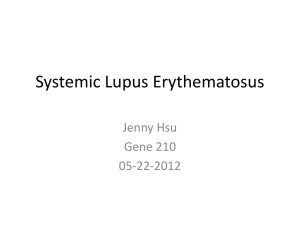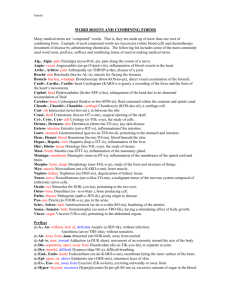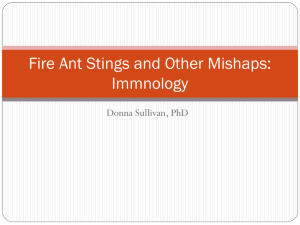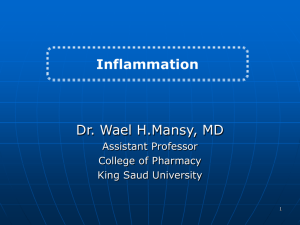Review questions for Immune System
advertisement
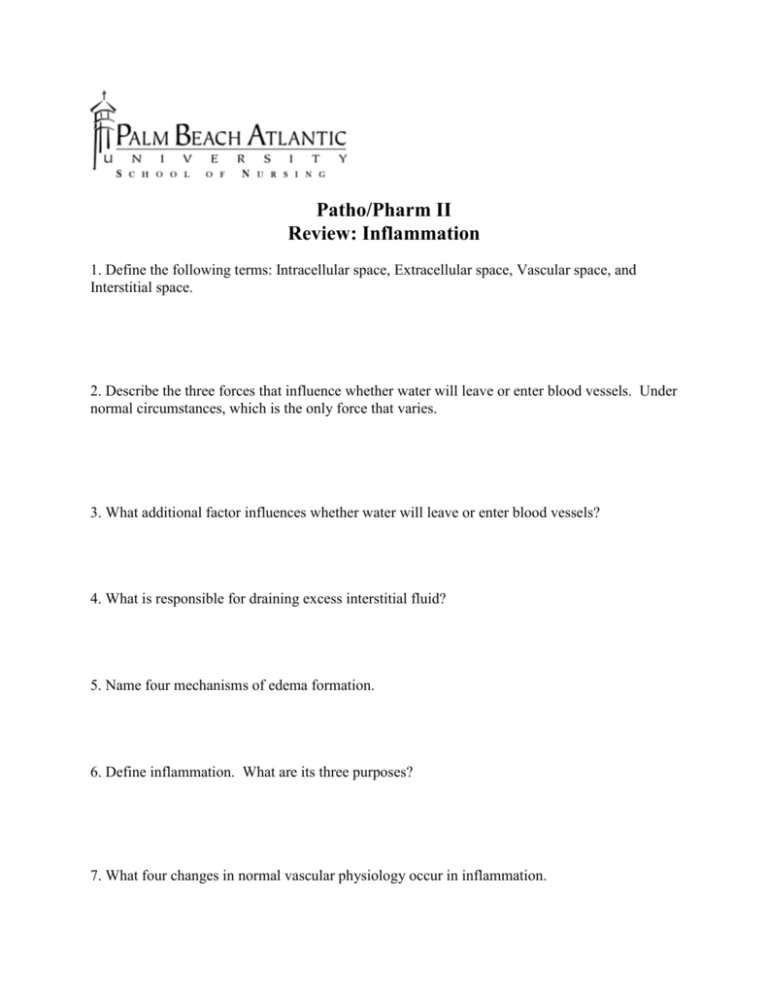
Patho/Pharm II Review: Inflammation 1. Define the following terms: Intracellular space, Extracellular space, Vascular space, and Interstitial space. 2. Describe the three forces that influence whether water will leave or enter blood vessels. Under normal circumstances, which is the only force that varies. 3. What additional factor influences whether water will leave or enter blood vessels? 4. What is responsible for draining excess interstitial fluid? 5. Name four mechanisms of edema formation. 6. Define inflammation. What are its three purposes? 7. What four changes in normal vascular physiology occur in inflammation. 8. What are the four classic signs of inflammation? Describe how the four changes above result in three of the classic signs. 9. What is the fifth sign of inflammation? 10. Define margination. Define emigration. List two other words that are used to describe emigration. 11. Define chemokine and chemotaxis. What does it mean that chemotaxis is gradient driven? 12. What does it mean that inflammation is non-specific? 13. List the four major types of inflammatory mediators. 14. What are the primary effects of histamine in inflammation? What role does histamine play in homeostasis (not inflammation)? 15. Name six drugs that inhibit the inflammatory effects of histamine. List four drugs that inhibit the homeostatic effects of histamine. 16. List the three arachidonic acid metabolites. 17. What role do prostaglandins play in inflammation? What role do they play in homoestasis? 18. How are prostaglandins produced? What are the drugs that inhibit prostaglandin production called? List give such drugs. 19. What role do thromboxanes play in inflammation? 20. What are drugs that inhibit leukotrienes used for? Name the most common drug. 21. What are ICAM and VCAM? What do they do? 22. What is a cytokine? 23. What is a zymogen? Name at least three zymogens and their products. 24. Chart the process of hematopoiesis from pluripotent stem cell to red blood cells, white blood cells, and platelets. 25. What does the term progressive differentiation mean? Give an example of a cell that does this? 26. What cells come from the lymphoid progenitor? 27. What cells come from the myeloid progenitor? 28. What is the difference between monocytes and macrophages? Where does each one live? 29. What are the names for macrophages that live in the liver, nervous system, skin, and connective tissue? 20. What does it mean that macrophages are effector cells? That they are phagocytic? 21. What does antigen presenting mean? 22. How do macrophages recognize pathogens? 23. What is a granuloma? How are they formed? Why are they formed? 24. What are dendritic cells? 25. What is macropinocytosis? 26. What are the two functions of dendritic cells? 27. What are mast cells best known for producing? 28. Why are granulocytes called granulocytes? 29. What are the three granulocytes? What is the primary role of each? 30. Describe neutrophils’ characteristics and function. 31. What are immature neutrophils called? What is it called when their numbers are elevated? Why are the significant when elevated? 32. Describe the two types of neutrophilic exudates. 33. What is best outcome for inflammation? Describe the process for tissue repair 34. What does parenchyma mean? 35. What is the difference between primary and secondary intention? 36. What factors influence inflammation and healing? 37. What are the systemic effects of inflammation? Immune System 1. What are the three functions of the immune system? 2. What are the different between Innate/Natural Immunity and Acquired Immunity? 3. What do the terms specific and non-specific mean? 4. What are the two types of specific immunity, and what cell/substances are involved. 5. Define the following terms: Recognition Effector Memory 6. What is an antigen? What is the relationship between antigen and epitope? What is a multivalent antigen? 7. What are MHC I & II. What cells produce/express each? What is the purpose of each? 8. What aspects of the body make up natural or immunity? 9. What is the difference between a T cell and a T lymphocyte? B cell and B lymphocyte? 10. What are the three subtypes of T cell? 11. Where do B cells mature? Where do T cells mature? 12. What property do all lymphocytes share in common? 13. Describe the process lymphocytes undergo in order to mount an immune response. 14. What is the B cell receptor? 15. What is an immunoglobulin (Ig)? What kinds of Ig do B cells naturally produce? 16. What is the name for a mature B cell? 17. Draw and label the basic structure of an antibody. Which portion controls what antigen the antibody will bind to? Which portion determines the effector function? 18. How do we think antibodies bind to antigen? What factors can disrupt the bond? 19. What is affinity? 20. How many classes of Ig are there? 21. What makes IgM special? 22. Why do IgM molecules join together to form pentameters? 23. What is the process whereby plasma cells mutate to produce higher affinity antibody called? What directs the process? 24. What are the four functions of antibodies? Name and describe each one. 25. When do most T cells mature? 26. What are the two antigens that T cells produce, and what cells do they become? 27. What do cytotoxic T cells do? What kinds of infections/conditions do they fight? 28. What is the function of each type of Helper T cells? 29. What are the two primary lymphoid organs? What makes them primary? 30. What are the secondary lymphoid organs/tissues? 31. What is the purpose of complement cascade? What is the end product (name and result)? 32. What are the three ways that the complement cascade can be activated? 33. What are the three things that can bind to complement C1q receptor? 34. Once a pathogen invades the body, how does the immune system become activated? 33. What is inflammation’s role in the immune response? 34. What is the purpose behind the increase in vascular permeability in inflammation? 35. What are the purposes behind fever? 36. What is the acute phase response? 37. What does TNF-α do? 38. Describe the process of septic shock, and TNF-α's role. 39. What do T cells require in order to be activated? 40. Once activated, what do T cells do? 41. How do B cells become activated? What do B cells require for maximum effectiveness? 42. Describe the concept of linked recognition. 43. What are memory cells and what to they do? 44. What is the difference between active and passive immunization? Give an example of each. 45. Why do some vaccinations require booster shots? 46. What are toxoid vaccines? Immunosuppressants 1. What are the major classes of immunosuppressants? List the drugs that belong to each class. 2. What are the major adverse effects that are common to all immunosuppressants? 3. Immediately following transplant, how much methylprednisolone would be given in response to a fever? Hypersensitivity 1. Define hypersensitivity reactions. 2. List the four types and describe the process, signs and symptoms, and common causes for each one.Infections 1. What are the three requirements for infection? 2. How should colonizations be treated as opposed to true infections? 3. Describe how each of the factors that affects transmissibility works. 4. What are the four stages of invasion? 5. What is lateral spreading? 6. Discuss five ways that pathogens can cause disease. 7. What are opportunistic infections? 8. List three causes of opportunistic diseases.




